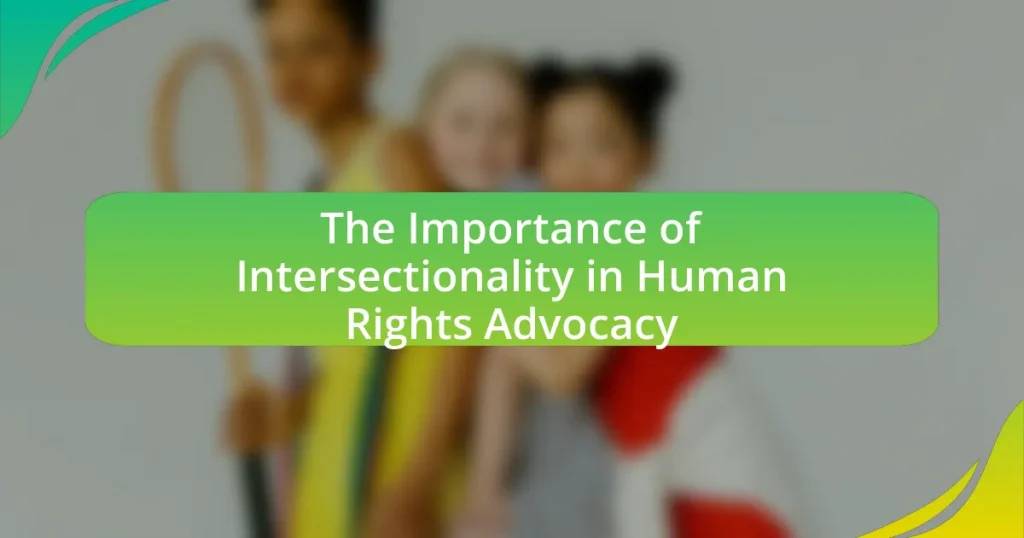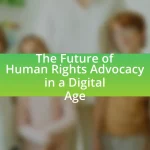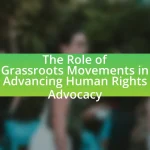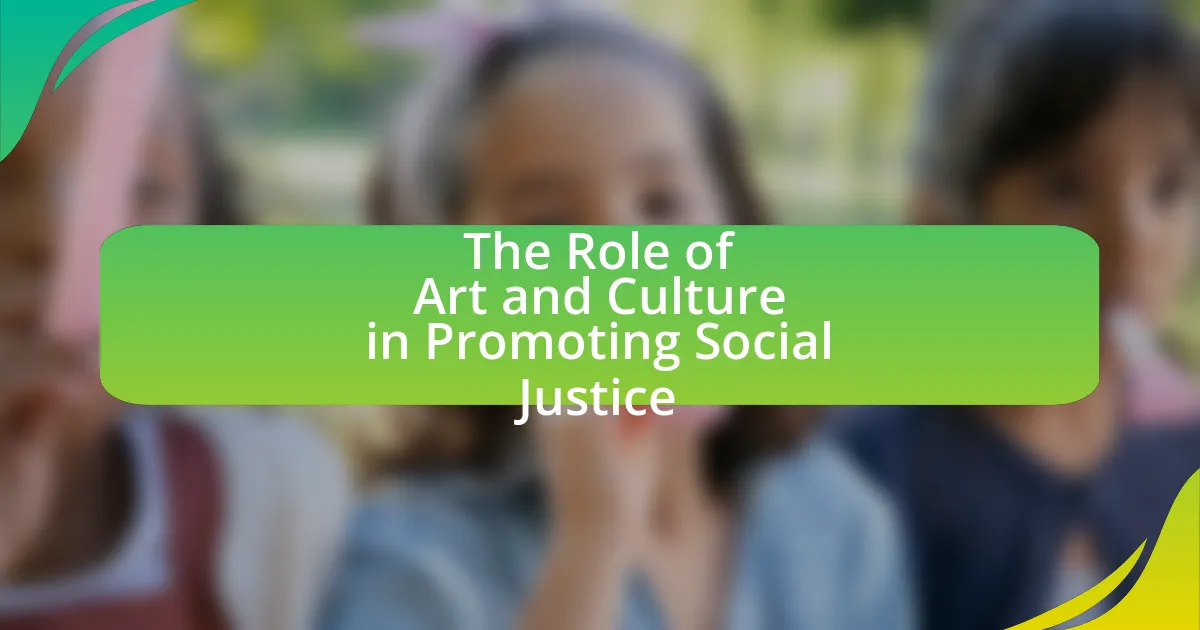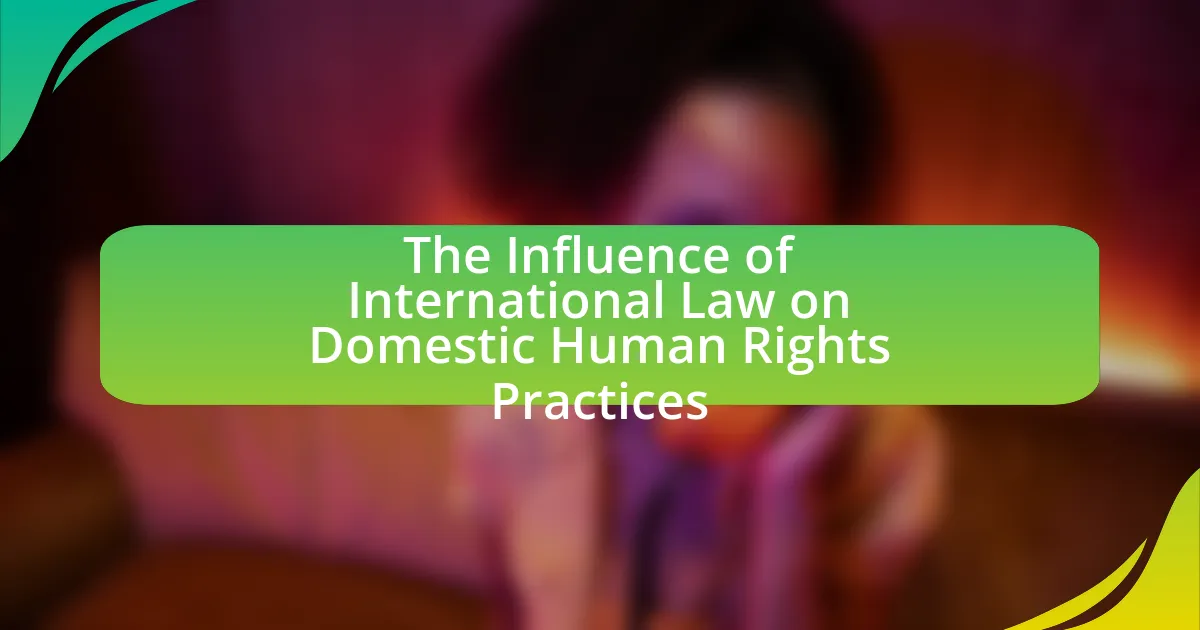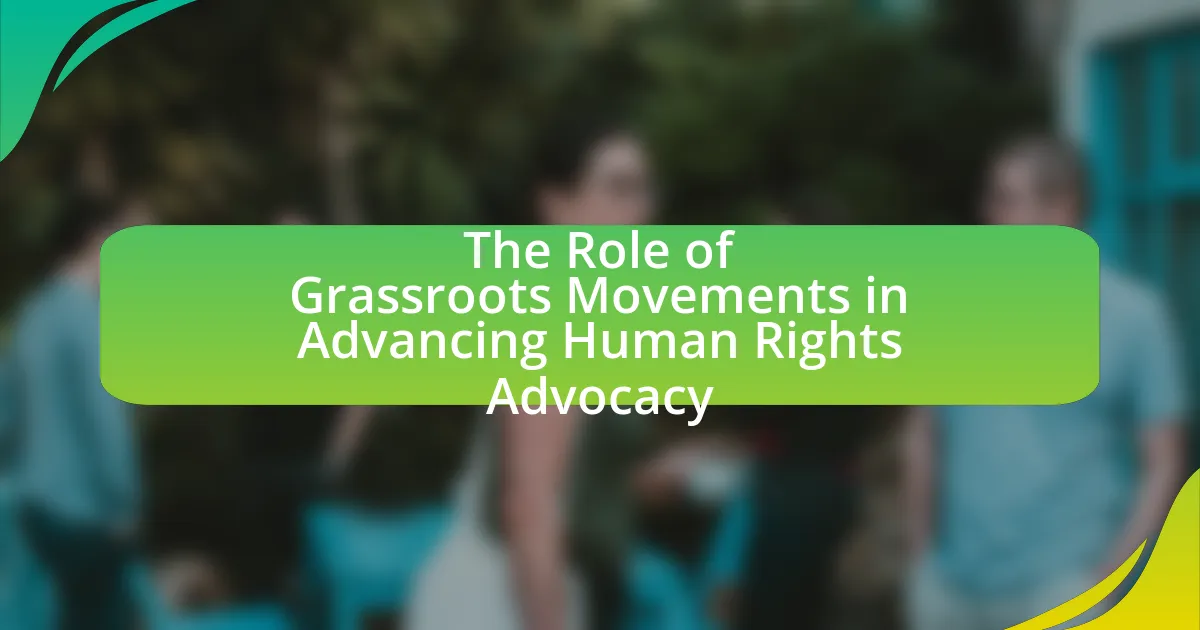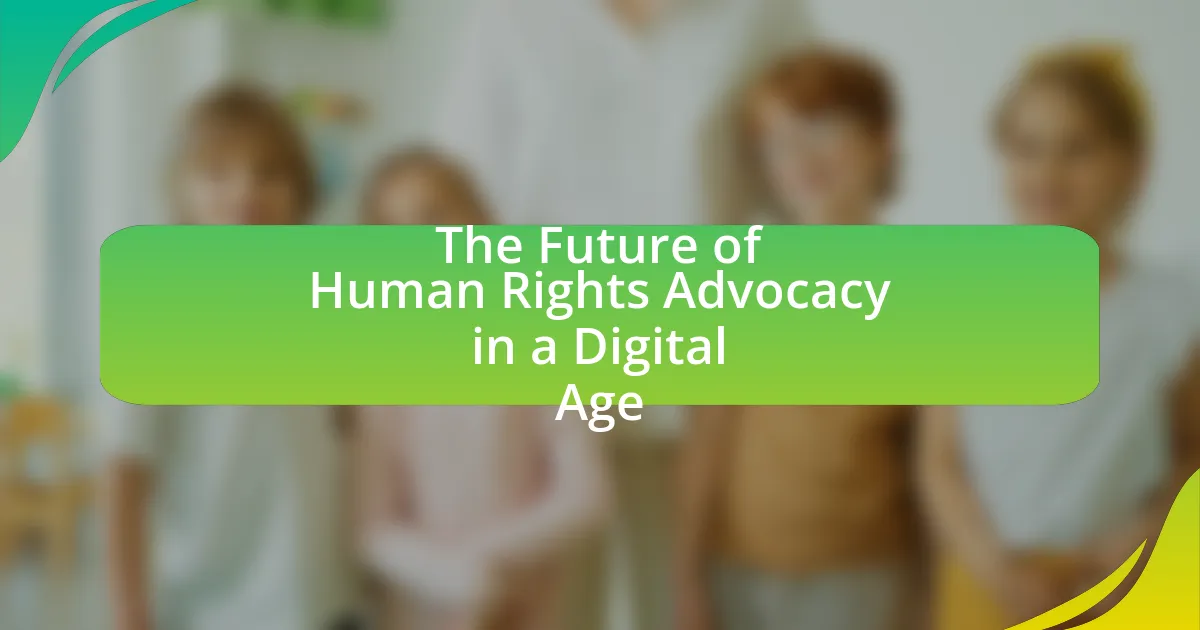Intersectionality in human rights advocacy is a framework that examines how overlapping social identities—such as race, gender, sexuality, and class—interact to create unique experiences of discrimination and privilege. Introduced by Kimberlé Crenshaw in 1989, this concept emphasizes the necessity of understanding these intersections to effectively address systemic inequalities and inform policy-making. The article explores the emergence of intersectionality in human rights discourse, its key principles, and its significance in shaping inclusive advocacy strategies. It also discusses the challenges advocates face in applying intersectional approaches, the potential consequences of neglecting this framework, and the resources available to support intersectional efforts in promoting social justice.
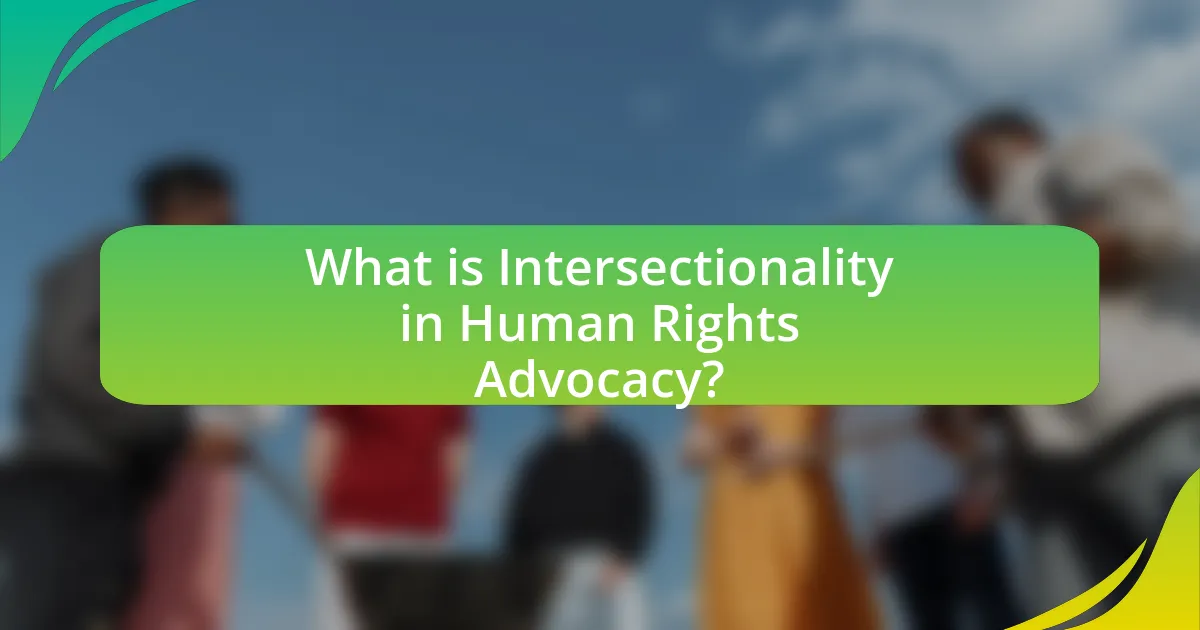
What is Intersectionality in Human Rights Advocacy?
Intersectionality in human rights advocacy refers to the framework that examines how various social identities—such as race, gender, sexuality, and class—intersect to create unique experiences of discrimination and privilege. This concept, introduced by Kimberlé Crenshaw in 1989, highlights that individuals do not experience oppression in isolation but rather through overlapping social categories that shape their lived realities. For instance, a Black woman may face both racial and gender discrimination simultaneously, which cannot be fully understood by analyzing race or gender separately. This understanding is crucial for effective human rights advocacy, as it ensures that policies and interventions address the complexities of individuals’ experiences rather than applying a one-size-fits-all approach.
How did the concept of intersectionality emerge in human rights discourse?
The concept of intersectionality emerged in human rights discourse primarily through the work of Kimberlé Crenshaw in the late 1980s, who highlighted how overlapping social identities, such as race, gender, and class, create unique modes of discrimination. Crenshaw’s analysis illustrated that traditional frameworks of human rights often failed to address the complexities faced by individuals at the intersections of multiple marginalized identities, leading to inadequate protections and advocacy. Her seminal paper, “Mapping the Margins: Intersectionality, Identity Politics, and Violence against Women of Color,” published in 1991, provided a foundational understanding of how intersectionality is essential for a comprehensive approach to human rights, emphasizing that policies must consider the multifaceted nature of discrimination to be effective.
What are the key principles of intersectionality?
The key principles of intersectionality include the recognition that individuals experience overlapping social identities, which can lead to unique forms of discrimination and privilege. This framework emphasizes that social categories such as race, gender, class, sexuality, and ability do not exist independently but interact to shape individual experiences and systemic inequalities. For example, a Black woman may face both racial and gender discrimination simultaneously, which cannot be understood by examining race or gender in isolation. Intersectionality was first coined by Kimberlé Crenshaw in 1989, highlighting the need for a more nuanced understanding of social justice issues. This principle is crucial in human rights advocacy as it ensures that policies and practices address the complexities of individuals’ lived experiences, rather than applying a one-size-fits-all approach.
How does intersectionality differ from traditional human rights approaches?
Intersectionality differs from traditional human rights approaches by emphasizing the interconnectedness of various social identities and their cumulative impact on discrimination and privilege. Traditional human rights frameworks often focus on individual rights and universal principles, potentially overlooking how overlapping identities—such as race, gender, class, and sexuality—can create unique experiences of oppression. For instance, Kimberlé Crenshaw, who coined the term “intersectionality,” highlighted that Black women face discrimination that is not solely based on race or gender but on the intersection of both, which traditional frameworks may inadequately address. This nuanced understanding allows for more comprehensive advocacy that recognizes and responds to the complexities of individuals’ lived experiences.
Why is intersectionality crucial for effective human rights advocacy?
Intersectionality is crucial for effective human rights advocacy because it recognizes that individuals experience overlapping forms of discrimination and privilege based on their identities, such as race, gender, sexuality, and socioeconomic status. This framework allows advocates to address the unique challenges faced by marginalized groups, ensuring that policies and interventions are inclusive and equitable. For instance, the 2015 report by the United Nations Human Rights Council emphasized that understanding intersectionality is essential for addressing systemic inequalities and promoting social justice, as it highlights how different forms of oppression intersect and compound each other. By incorporating intersectionality into advocacy efforts, organizations can create more comprehensive strategies that effectively address the needs of diverse populations, ultimately leading to more impactful human rights outcomes.
What are the potential consequences of ignoring intersectionality in advocacy?
Ignoring intersectionality in advocacy can lead to ineffective strategies that fail to address the unique challenges faced by marginalized groups. When advocacy efforts do not consider the overlapping identities of individuals, such as race, gender, sexuality, and socioeconomic status, they risk perpetuating systemic inequalities. For example, research by the American Psychological Association highlights that marginalized individuals often experience compounded discrimination, which can result in poorer health outcomes and reduced access to resources. Consequently, advocacy that overlooks these complexities may not only alienate those it aims to support but also reinforce existing power dynamics, ultimately undermining the goals of social justice and equity.
How does intersectionality enhance the understanding of marginalized groups?
Intersectionality enhances the understanding of marginalized groups by recognizing that individuals experience multiple, overlapping identities that shape their unique experiences of discrimination and privilege. This framework allows for a more nuanced analysis of social issues, as it considers how factors such as race, gender, sexuality, and class interact to create distinct forms of oppression. For example, a study by Crenshaw (1989) highlighted how Black women face discrimination that is not fully addressed by either feminist or anti-racist movements alone, illustrating the necessity of an intersectional approach to advocate effectively for their rights. By incorporating intersectionality, advocates can develop targeted strategies that address the specific needs and challenges faced by diverse marginalized communities, leading to more equitable outcomes in human rights advocacy.
What role does intersectionality play in shaping human rights policies?
Intersectionality plays a crucial role in shaping human rights policies by ensuring that diverse identities and experiences are considered in the formulation and implementation of these policies. This approach recognizes that individuals may face multiple, overlapping forms of discrimination based on race, gender, sexuality, class, and other social categories, which can compound their vulnerability and marginalization. For instance, the United Nations’ 2018 report on the rights of women highlighted how intersectional discrimination affects women differently depending on their socio-economic status and ethnicity, thereby influencing policy recommendations to address these specific needs. By integrating intersectionality into human rights frameworks, policymakers can create more inclusive and effective strategies that address the unique challenges faced by various groups, ultimately leading to more equitable outcomes.
How can intersectional analysis inform policy-making processes?
Intersectional analysis can inform policy-making processes by highlighting the diverse and overlapping social identities that affect individuals’ experiences and access to resources. This approach enables policymakers to understand how factors such as race, gender, socioeconomic status, and disability intersect, leading to unique challenges for marginalized groups. For instance, research by Crenshaw (1989) emphasizes that policies designed without considering these intersections may inadvertently perpetuate inequalities, as they often fail to address the specific needs of those who face multiple forms of discrimination. By integrating intersectional analysis into policy development, governments can create more equitable and effective solutions that address the complexities of social justice and human rights.
What examples exist of intersectionality influencing human rights legislation?
Intersectionality has significantly influenced human rights legislation through various frameworks and legal reforms. One prominent example is the United Nations Convention on the Elimination of All Forms of Discrimination Against Women (CEDAW), which recognizes the need to address multiple forms of discrimination that women face, including race, class, and sexual orientation. This convention has led to national laws that incorporate intersectional perspectives, such as the Equality Act 2010 in the United Kingdom, which protects against discrimination based on multiple characteristics, including gender, race, and disability. Additionally, the U.S. Supreme Court case of Obergefell v. Hodges (2015) highlighted the intersection of sexual orientation and gender identity in the context of marriage equality, influencing state laws and policies to recognize same-sex marriage. These examples illustrate how intersectionality shapes human rights legislation by ensuring that diverse experiences and identities are acknowledged and protected.
How can advocates effectively incorporate intersectionality into their work?
Advocates can effectively incorporate intersectionality into their work by actively recognizing and addressing the interconnected nature of social categorizations such as race, gender, and class. This approach requires advocates to conduct thorough research on the specific needs and experiences of diverse communities, ensuring that their strategies and policies reflect the complexities of individuals’ identities. For instance, the 2017 report by the American Psychological Association highlights that intersectional frameworks lead to more comprehensive understanding and solutions in advocacy efforts. By integrating data and narratives from marginalized groups, advocates can create more inclusive programs that address systemic inequalities, ultimately enhancing the effectiveness of their human rights initiatives.
What strategies can be employed to promote intersectional approaches in advocacy?
To promote intersectional approaches in advocacy, organizations should implement collaborative frameworks that integrate diverse voices and experiences. This can be achieved by actively engaging marginalized communities in the decision-making process, ensuring that their unique perspectives inform advocacy strategies. Research indicates that inclusive advocacy efforts lead to more effective policy outcomes, as seen in the work of the Women’s March, which emphasizes intersectionality in its mission to address various forms of discrimination. Additionally, training advocates on intersectionality can enhance their understanding of how overlapping identities impact individuals’ experiences, thereby fostering more comprehensive advocacy efforts.
How can organizations measure the impact of intersectional advocacy?
Organizations can measure the impact of intersectional advocacy by utilizing a combination of qualitative and quantitative metrics. These metrics include tracking changes in policy, analyzing demographic data to assess representation, and conducting surveys to gauge community perceptions and experiences. For instance, a study by the Center for Intersectionality and Social Policy Studies found that organizations employing intersectional frameworks reported a 30% increase in policy engagement among marginalized groups. This demonstrates that effective measurement can reveal the tangible benefits of intersectional advocacy, such as improved representation and enhanced community support.
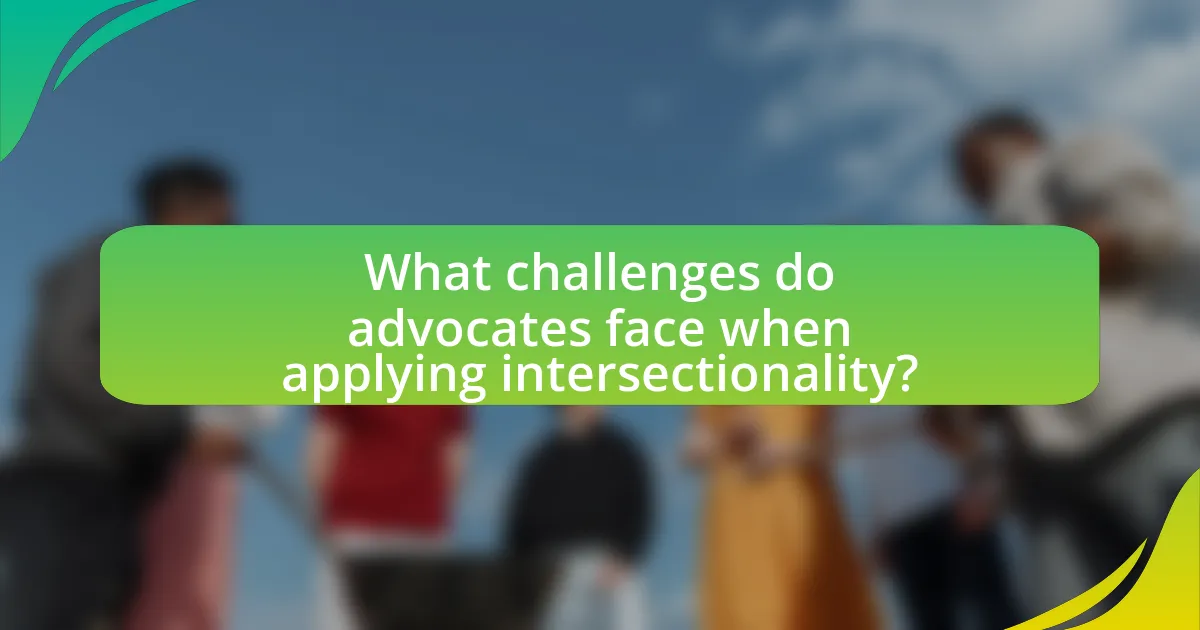
What challenges do advocates face when applying intersectionality?
Advocates face several challenges when applying intersectionality, primarily due to the complexity of overlapping identities and systemic inequalities. This complexity can lead to difficulties in accurately representing the diverse experiences of individuals who belong to multiple marginalized groups. For instance, advocates may struggle to address the unique needs of individuals who experience both racial and gender discrimination, as traditional frameworks often focus on single-axis analyses. Additionally, there is often a lack of resources and training on intersectional approaches within organizations, which can hinder effective advocacy. Research by Crenshaw (1989) highlights that without an intersectional lens, advocacy efforts may inadvertently reinforce existing power dynamics and fail to address the root causes of inequality.
What are common misconceptions about intersectionality in human rights work?
Common misconceptions about intersectionality in human rights work include the belief that it only addresses issues of race and gender, neglecting other identities such as class, sexuality, and disability. This oversimplification fails to recognize that intersectionality encompasses the interconnected nature of various social categorizations and their cumulative impact on individuals’ experiences of oppression. Additionally, some assume that intersectionality is merely a theoretical framework rather than a practical tool for advocacy, which undermines its application in real-world human rights initiatives. Research by Crenshaw (1989) highlights how ignoring intersectional identities can lead to inadequate policy responses that do not address the unique challenges faced by marginalized groups.
How can advocates address resistance to intersectional approaches?
Advocates can address resistance to intersectional approaches by employing education and awareness strategies that highlight the interconnectedness of social identities and their impact on human rights. By providing concrete examples and data, such as the 2017 report by the American Psychological Association, which illustrates how individuals with multiple marginalized identities face compounded discrimination, advocates can effectively demonstrate the necessity of intersectionality in advocacy efforts. Engaging in dialogue that emphasizes shared experiences and collective struggles can also foster understanding and reduce resistance, as seen in community-based initiatives that successfully integrate diverse perspectives into policy-making processes.
What barriers exist in implementing intersectional strategies in advocacy?
Barriers in implementing intersectional strategies in advocacy include lack of awareness, insufficient resources, and resistance to change. Lack of awareness among advocates and organizations about the importance of intersectionality can lead to oversimplified approaches that fail to address the complexities of individuals’ identities. Insufficient resources, such as funding and training, hinder the ability to develop and execute comprehensive intersectional strategies. Additionally, resistance to change within organizations can stem from entrenched practices and a reluctance to challenge existing power dynamics, which can impede the adoption of more inclusive advocacy methods. These barriers collectively limit the effectiveness of advocacy efforts aimed at addressing the multifaceted nature of discrimination and inequality.
How can advocates overcome these challenges?
Advocates can overcome challenges in human rights advocacy by employing intersectional approaches that recognize and address the diverse experiences of marginalized groups. By integrating perspectives from various identities, such as race, gender, and socioeconomic status, advocates can create more inclusive strategies that resonate with a broader audience. Research by Crenshaw (1989) highlights that intersectionality allows for a deeper understanding of how overlapping identities contribute to unique forms of discrimination, thereby informing more effective advocacy efforts. This approach not only enhances the relevance of advocacy initiatives but also fosters solidarity among different groups, ultimately leading to more comprehensive and impactful human rights outcomes.
What resources are available to support intersectional advocacy efforts?
Resources available to support intersectional advocacy efforts include organizations, toolkits, funding opportunities, and educational materials. Organizations such as the National Women’s Law Center and the Human Rights Campaign provide frameworks and support for intersectional approaches. Toolkits like the “Intersectionality Toolkit” by the Ford Foundation offer practical guidance for implementing intersectional strategies in advocacy. Additionally, funding opportunities from entities like the Open Society Foundations specifically target intersectional initiatives, enabling diverse groups to address overlapping social injustices. Educational materials, including research papers and webinars, further enhance understanding and implementation of intersectional advocacy.
How can collaboration enhance the effectiveness of intersectional approaches?
Collaboration enhances the effectiveness of intersectional approaches by bringing together diverse perspectives and expertise, which allows for a more comprehensive understanding of complex social issues. When individuals and organizations collaborate, they can identify and address the overlapping systems of oppression that affect marginalized communities, leading to more targeted and effective advocacy strategies. For instance, research by Crenshaw (1989) highlights how intersectionality reveals the unique challenges faced by individuals at the intersections of multiple identities, such as race, gender, and class. Collaborative efforts can leverage this understanding to create inclusive policies and initiatives that better serve these communities, ultimately improving the outcomes of human rights advocacy.
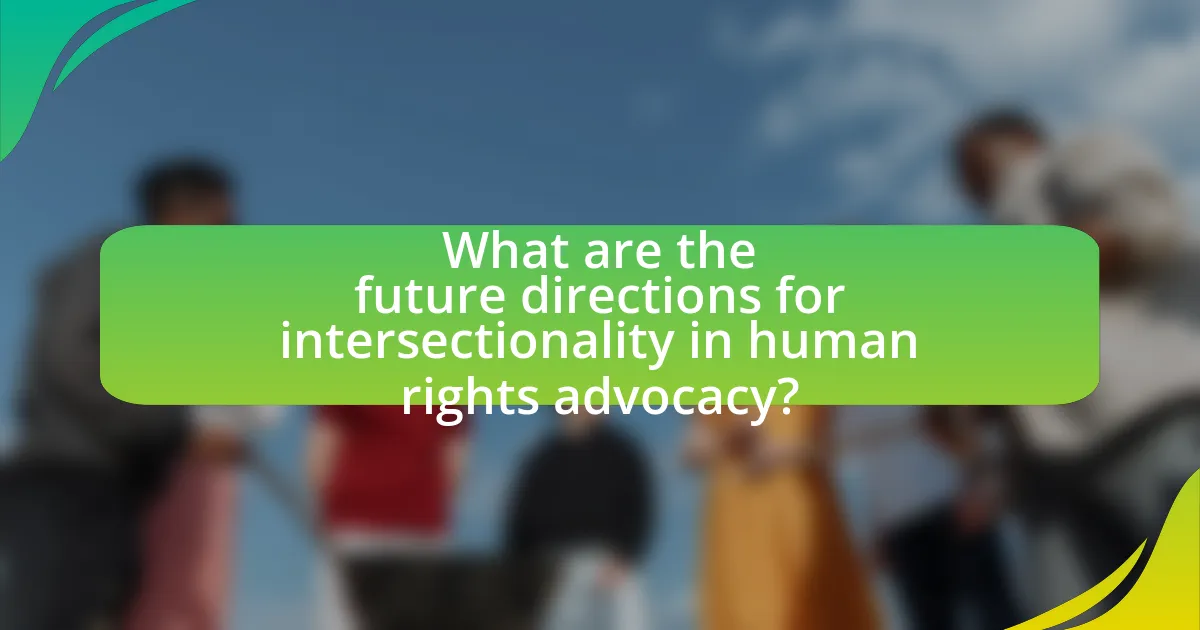
What are the future directions for intersectionality in human rights advocacy?
Future directions for intersectionality in human rights advocacy include the integration of diverse identities into policy-making and the emphasis on collaborative frameworks that address systemic inequalities. Advocacy efforts are increasingly focusing on the interconnectedness of race, gender, sexuality, and socioeconomic status, which is essential for creating comprehensive human rights protections. For instance, organizations like the United Nations have recognized the need for intersectional approaches in their reports, highlighting that marginalized groups often face compounded discrimination. This shift towards intersectionality aims to ensure that human rights frameworks are inclusive and responsive to the complexities of individual experiences, ultimately leading to more effective advocacy and policy outcomes.
How is the understanding of intersectionality evolving in the context of global human rights?
The understanding of intersectionality in the context of global human rights is evolving to recognize the interconnectedness of various social identities and their impact on individuals’ experiences of discrimination and privilege. This evolution is evident in the increasing incorporation of intersectional frameworks in human rights advocacy, which emphasizes that issues such as race, gender, sexuality, and class cannot be addressed in isolation. For instance, the United Nations has acknowledged the importance of intersectionality in its reports and initiatives, highlighting how marginalized groups face compounded discrimination. This shift is supported by research from scholars like Kimberlé Crenshaw, who coined the term “intersectionality,” demonstrating that legal frameworks must adapt to address the complexities of overlapping identities to ensure equitable human rights protections.
What emerging issues highlight the need for intersectional advocacy?
Emerging issues such as climate change, systemic racism, and gender-based violence highlight the need for intersectional advocacy. Climate change disproportionately affects marginalized communities, exacerbating existing inequalities in health, housing, and economic stability. Systemic racism continues to intersect with various forms of discrimination, leading to disparities in justice, education, and employment opportunities. Gender-based violence, particularly against women of color and LGBTQ+ individuals, underscores the necessity for advocacy that considers multiple identities and experiences. These issues demonstrate that a one-size-fits-all approach is inadequate; intersectional advocacy is essential to address the complex realities faced by diverse populations effectively.
How can technology and social media support intersectional human rights efforts?
Technology and social media can support intersectional human rights efforts by amplifying marginalized voices and facilitating global connectivity. These platforms enable activists to share their experiences and mobilize support across diverse communities, fostering solidarity among various social justice movements. For instance, the #BlackLivesMatter movement utilized social media to highlight systemic racism and police brutality, demonstrating how digital tools can raise awareness and drive collective action. Additionally, technology provides access to information and resources, empowering individuals to advocate for their rights and engage in policy discussions. According to a report by the Pew Research Center, 69% of adults in the U.S. use social media, illustrating its potential reach for promoting intersectional human rights initiatives.
What practical steps can advocates take to promote intersectionality today?
Advocates can promote intersectionality today by actively incorporating diverse perspectives into their advocacy efforts. This includes forming coalitions with marginalized groups to ensure that their unique experiences and challenges are represented in policy discussions. For instance, research by the American Psychological Association highlights that intersectional approaches lead to more effective advocacy outcomes by addressing the complexities of identity and systemic oppression. Additionally, advocates should prioritize education and training on intersectionality within their organizations to foster a deeper understanding of how various social identities interact. By implementing these strategies, advocates can create a more inclusive and effective human rights framework.
What best practices should advocates follow to ensure intersectional approaches are effective?
Advocates should prioritize inclusive representation and collaboration to ensure intersectional approaches are effective. This involves actively engaging diverse communities and stakeholders in the advocacy process, which enhances understanding of the unique challenges faced by different groups. Research indicates that inclusive practices lead to more comprehensive and effective policy outcomes, as seen in the 2019 report by the United Nations, which highlights the importance of integrating multiple identities in human rights frameworks. Additionally, advocates should utilize data disaggregation to identify and address specific needs within intersecting identities, thereby tailoring interventions that resonate with varied experiences.
How can individuals contribute to intersectional human rights advocacy in their communities?
Individuals can contribute to intersectional human rights advocacy in their communities by actively engaging in education and awareness initiatives that highlight the interconnectedness of various social identities and issues. By organizing workshops, discussions, and campaigns that address the unique challenges faced by marginalized groups, individuals can foster a deeper understanding of intersectionality. Research indicates that communities that prioritize intersectional approaches are more effective in addressing systemic inequalities, as seen in the work of organizations like the Intersectional Justice Project, which emphasizes the importance of inclusive advocacy strategies.
